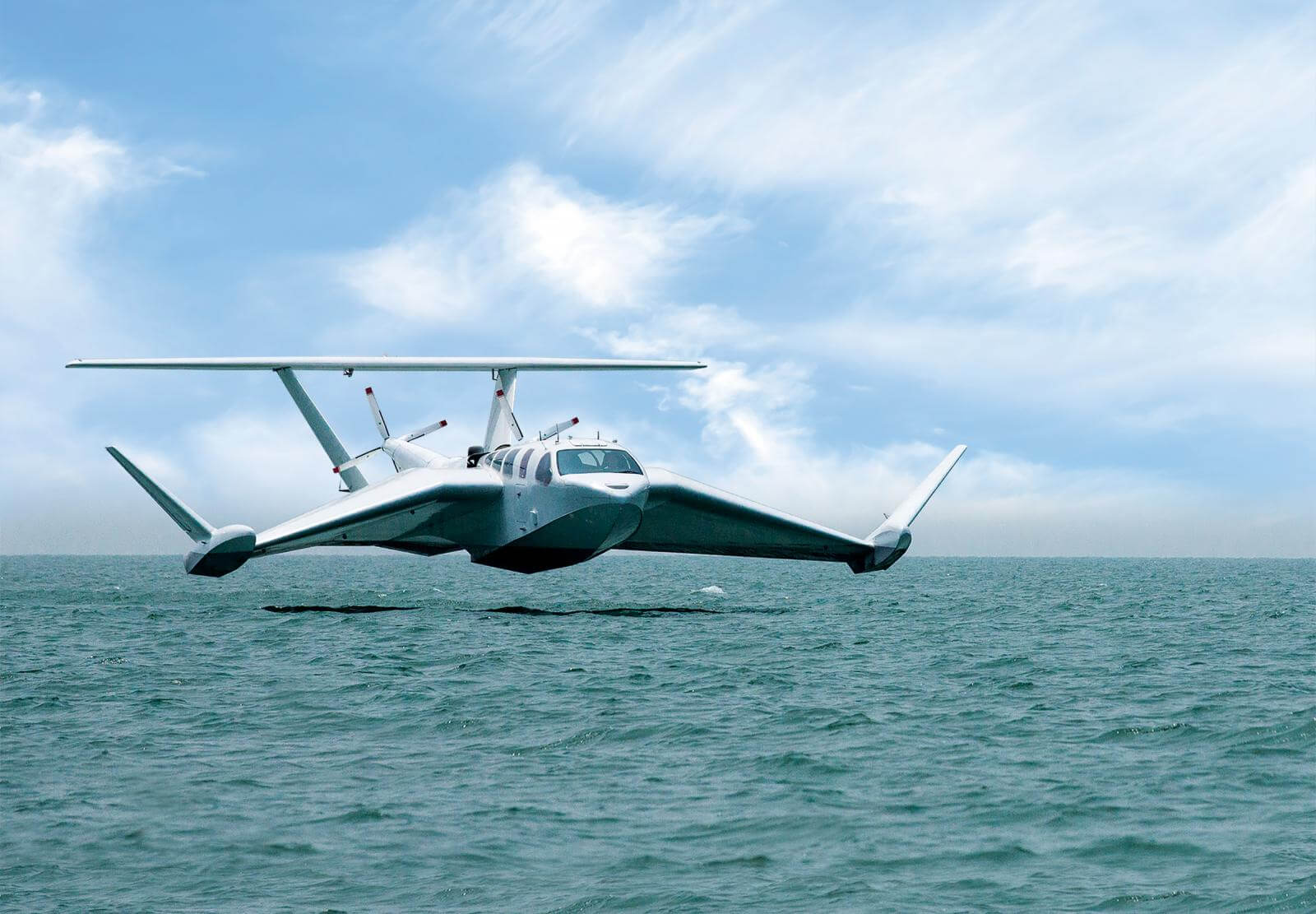
GROUND EFFECT MARITIME VEHICLES: A RESURGENCE?

On October 16, 1966, a monstrous 300-foot-long aircraft, longer than a Boeing-747, with a 125-foot wingspan/121-foot tail-stabiliser span, glided over the Caspian Sea. The machine was as high as a six-story building, with a maximum take-off weight of 544 Tons, and a capacity of 55 personnel, including crew. The gargantuan machine was powered by 10 Dobrynin VD-7 Turbojet engines, generating a total thrust of 1275 kN, almost double that of a C-17 Globemaster! What exactly was this massive work of engineering??

Artist’s Impression of the US’ Liberty Lifter GEMV:Source-darpa.mil
Enter the Soviet Union’s KM Ekranoplan, or ‘Ground-effect Vehicle (GEV)’, colloquially dubbed the Caspian Sea Monster! The Ekranoplan was an experimental Ground-effect Maritime Vehicle (GEMV) built by the Soviet Union’s Central Hydrofoil Design Bureau in the mid-1960s and remained a test project for the next 14 years, until it crashed in the Caspian Sea in 1980, due to pilot error.
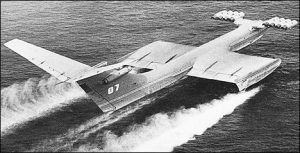
The KM Ekranoplan:Source-hushkit.net
As the category suggests, hydrofoils are lifting surfaces, or foils, that operate in water and are similar in appearance to an aircraft wing. Crafts using such hydrofoil technology are termed hydrofoils. The Ekranoplan was designed to use hydrofoils to enable maritime transportation of personnel/stores over large distances and for maritime rescue, at speeds unmatched by any maritime surface/sub-surface craft. The craft was also mostly immune to radar detection since it flew below minimum detection altitude of most radars. As a hydrofoil craft gains momentum, the hydrofoils lift the boat’s hull out of the water, decreasing drag and allowing greater speeds. The Ekranoplan was capable of speeds up to 500 Kmph, with a radius of action of 1500 Km, which immediately brought its employment into the operational domain. It was capable of Ground-effect altitudes of between 4 and 14 m, enabling to negotiate up to Sea-state 3, with sea swells of up to 1.2 m, giving it a fair capability over calm/mildly turbulent waters. Incidentally, the prototype Ekranoplan, with its impressive dimensions mentioned above, was assigned to the Soviet Navy, and remains the second-largest aircraft ever built, behind the Antonov AN-225 Mriya aircraft!
This prototype Ekranoplan was the precursor for the Lun-class Ekranoplan (Soviet Project 903) developed by the same Soviet Agency in the 1980s. This craft was the only GEMV to be operationally deployed as a Naval surface vessel, wherein it was deployed as a warship with the Caspian Flotilla of the Soviet Navy and later the Russian Navy before being decommissioned a decade later. The craft mounted six P-270 Moskit guided-missiles over the fuselage (picture below).
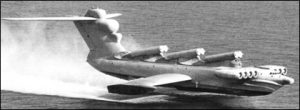
The Lun-class Ekranoplan in Flight: Source-silodrome.com
The Ekranoplan program continued, developing and producing the 125-ton A-90 Orlyonok, a Type B/C GEMV (elucidated below). These craft were intended to be employed for high-speed transportation of military stores/personnel. The Soviet Navy ordered 120 A-90s, but accepted delivery of only a handful of units, which were intended to be deployed with the Black Sea/Baltic Sea Fleets. Funding to the project was cancelled by the Soviet Government in the mid-1980s. Smaller, commercial-use GEMVs continued to be produced for some years after the dissolution of the Soviet Union at the Volga Shipyard in Western Russia.
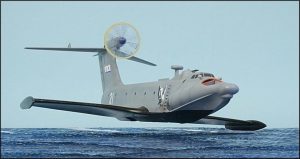
The A-90 Orlyonok GEMV:Source-alchetron.com
The US’ attempts at developing a ‘strategic lift flying boat’ commenced with the Spruce Goose, a massive 400,000-pound Hughes H-4 Hercules cargo plane that flew 70 feet above the ground for about a mile in 1947. This craft was developed in conjunction with the Pentagon for a similar mission as the Liberty Lifter (the ongoing US GEMV program), for transporting cargo across vast distances faster and at less risk of interception than a ship.
Definition/Operating Principle of GEMVs
A GEV, also called a wing-in-ground effect/ ground-effect craft, wingship, flarecraft or Ekranoplan, is a vehicle that can propel itself by gaining lift from the reactions of the air over the surface below. Typically, the craft is designed to glide over a level surface (usually over the sea) by making use of ground-effect, which is the aerodynamic interaction between the moving wing and the surface below, when the craft flies closer to the surface than the length of its wingspan. This causes low-pressure airflow above the wing and converse high-pressure airflow underneath the wing. This produces lift, enabling the craft to rise above the surface. However, these airflows also form vortices when they flow off the ends of the wings, causing lift-induced drag (LID). The proximity to the surface in the case of GEVs obviates the expansion of such vortices and thus reduces LID, thereby increasing fuel efficiency. Such craft designed for maritime use are termed as GEMVs. Some models can operate over land areas such as frozen lakes or flat plains, similar to a hovercraft.
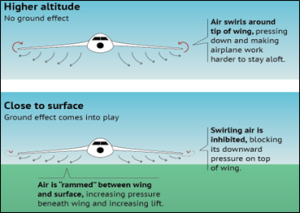
Source-aerospaceweb.org
Classification of GEMVs
Based on wing-configuration, GEMVs can be divided into three categories: –
(a) Straight-Wing. Relatively shorter wings, necessitating a larger tailplane for lift, and a rear stabiliser, as existed in the Ekranoplan.
(b) Reverse Delta-Wing. Allows stable flight in ground-effect through self- stabilization (Type-B GEMV, as elucidated below).
(c) Tandem-Wing. Biplane type-utilising a shoulder-mounted main lift wing and belly-mounted projections (Type-A); or Canard type– utilising a mid-size horizontal wing near the nose, which creates lift at a lower speed, thereby reducing water-drag and contributing to efficiency (Type-B); or two fuselage-mounted short wings, which lend towards self-stabilisation.
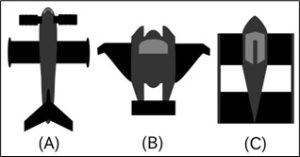
GEMV Wing Configuration:Source-en.wikipedia.org
Based on the ability to operate within/outside the ground-effect phenomenon, the International Maritime Organisation has broadly classified GEMVs into three categories:-
(a) Type-A: capable only of operating within ground-effect i.e. no more than one wingspan above the surface;
(b) Type-B: temporarily capable of flying out of ground-effect, but at no more than 150m above the surface.
(c) Type-C: capable of flying out of ground-effect, at heights above 150m. This Type typically uses the ground-effect only during take-off and landing, otherwise functioning as a normal airplane.
Success of GEMVs
Despite obvious advantages of fast and efficient transportation over water, the GEMVs rely on their downwash/the cushion effect from the water surface to stay airborne at extremely low altitudes, which requires a significant amount of power due to the phenomenon of water-drag, rendering a per-kilometer propulsion cost rate that is higher than most aircraft. GEMV operations are also only restricted to the vicinity of water bodies and they cannot operate freely over land. Operational hazards include the vulnerability of such craft to interception due to their low altitude and significantly less manouverability as compared to conventional aircraft. Another operational hazard that presents is the obvious clash of operational space with maritime and coastal trade. There is also the challenge of excessive corrosion due to salt water. The Ekranoplan, which also suffered from corrosion challenges, was only employed in the Caspian Sea, which has a lesser level of salinity than the open oceans. This aspect further impacted the confidence of developers in developing such craft for open-ocean employment. Extraction of such crafts for onshore maintenance/repair or for operational reasons is also restricted to certain areas which have favourable coastal terrain configurations for the same. This in the past rendered the GEMV operationally and economically inviable for fruitful employment.
Why Are GEMVs Seeing a Resurgence?
Fuel consumption and high-altitude environmental pollution are two factors which go against conventional airplanes. GEMVs provide a partial solution to both these problems and consume far less fuel than conventional aircraft due to the advantage of greater lift due to denser sea-level air and drag reduction, over long routes, at speeds over 500 Kmph. Cargo capacities of modern GEMVs would be comparable to/ exceed even that of strategic-lift aircraft like the C-17 Globemaster, making them the preferred option for long-range, heavy-duty maritime commercial/military transportation. Development of a large number of coastal airports across the globe would also facilitate use of conventional runways for take-off/landing, obviating the high-energy requirements for over-water take-off/landing operations. Maritime/amphibious operations would involve reinforcement/ replenishment/casualty evacuation at sea, making GEMVs ideally suited for brown/blue water Navies alike, while operating from littoral regions/coastal airports/island hubs.
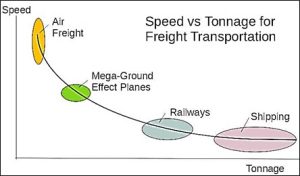
Source-maritime-executive.com
Present Global Trends in Military-Capable GEMVs
While a plethora of small, commercial GEMVs have been/are being developed by several countries, purely for small-scale commercial use, this article will concentrate on global trends of military-grade GEMVs, albeit which can also be employed commercially.
Design improvements in ongoing GEMV development projects in US, Russia and Europe would offer several advantages over erstwhile GEMV designs. Modern designs envision quick and seamless transition from an elevation of 5 % of the wingspan to 40%, which would facilitate manoeuverability/navigation of high sea-states, giving modern GEMVs near all-weather capability. Automated monitoring systems, adjustable rear-flaps and tilting propellers would also allow successful negotiation of rough seas/coastal obstructions.
The US Defence Advanced Research Project Agency’s (DARPA) Liberty Lifter Program (LLP) is currently designing a GEMV since mid-2022 to undertake logistics missions for the US Military and for commercial use. Liberty Lifter could also provide ‘sea-based search and rescue and disaster response at the scale of ships with the speed of air transport’. As per DARPA, the planned Liberty Lifter demonstrator will be ‘a large flying boat similar in size/capacity to the C-17 Globemaster III transport aircraft. Goals include take-off/landing in Sea-state 4, sustained on-water operation up to Sea-state 5, and extended flight close to the water in ground-effect, with the capability to fly out of ground effect to altitudes of 10,000 feet above sea level. The Pentagon had awarded design/development contracts to two firms, including General Atomics and Aurora Flight Sciences (a Boeing subsidiary). In the first phase of the contract, the two agencies were to develop a prototype to carry two amphibious combat vehicles or six 20-foot-long cargo containers at wavetop height using ground-effect. As per DARPA, General Atomics had selected a twin-hull, mid-wing design with 12 turboshaft engines to optimize on-water stability. Aurora Flight Sciences design resembles a traditional flying boat, with a single hull, high-wing and eight turboprops for primary propulsion. In May 2024, DARPA selected Aurora’s design to continue development . The LLP is presently focusing on platform design and risk-reduction in preparation for Preliminary Design Review in early 2025. The first flight is envisaged for late 2027/early 2028.
Russian aeronautical design firm Beriev (who had earlier developed the Be-1 and subsequently the Bartini Beriev VVA-14 GEMVs) has been developing the Be-2500 Neptun -a super heavy GEMV, under a US$ 15 Billion development program, which is likely to include foreign partners. The maximum take-off weight is estimated at 2500 tons. The Neptun is envisaged with a dual design-that of a conventional long-range airplane, with GEMV capabilities, thus according to the advantage of use of conventional runways for take-off/landing and maritime transportation. The GEMV is envisaged to be powered by six Kuznetsov NK-116 turbofans generating a thrust of 172 kN each, with a 1000-ton payload capacity, maximum take-off weight of 2500 tons, 123m length, 156 m wingspan, maximum ground-effect speed/range of 450 Kmph/10,700 Km respectively-thus according to it truly global reach.
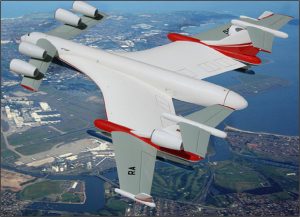
Representative Image of Be 2500:Source-repulnijo.hu
China Ship Scientific Research Center (CSSRC) has developed the XTW-4 (the fourth in a series of GEV prototypes). For the first time, CSSRC has used two turboprop engines in this craft. The XTW-4 was launched in September 1999 and by early 2000, trials on the Yangtze River were completed. The GEMV is intended for sea-operation and uses corrosion-resistant Aluminium alloy. It is reported to have successfully completed sea trials in early 2023. The GEMV reportedly has an endurance of six hours and a top speed of 240 Kmph. The enhanced seaworthiness of the craft will also enable negotiation in high sea-states. The South China Morning Post claims that the GEMV could be used for speedy transportation of goods/ personnel between Hainan and Chinese-controlled islands in the South China Sea, paving way for more high-end, long-range military applications.
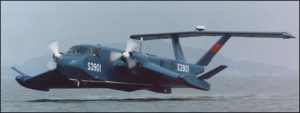
Alleged Image of Chinese XTW-4:Source-reddit.com
Conclusion
In an era where military transport technology is breaching new horizons, GEMV technology, in its resurgent form, holds promise as an alternative for fast, high-capacity overseas transportation that could offer significant strategic advantages to global players in a quest for maritime domain dominance.
Disclaimer
The opinions expressed in this article are the author’s own and do not reflect the views of Chanakya Forum. All information provided in this article including timeliness, completeness, accuracy, suitability or validity of information referenced therein, is the sole responsibility of the author. www.chanakyaforum.com does not assume any responsibility for the same.
Chanakya Forum is now on . Click here to join our channel (@ChanakyaForum) and stay updated with the latest headlines and articles.
Important
We work round the clock to bring you the finest articles and updates from around the world. There is a team that works tirelessly to ensure that you have a seamless reading experience. But all this costs money. Please support us so that we keep doing what we do best. Happy Reading
Support Us





















POST COMMENTS (0)